A lot of places boast
splendid Victorian architecture. Cape May, San Francisco,
Philadelphia, Brooklyn Heights, and Baltimore all come to mind. But
no place has as many examples of every style of Victorian
architecture as does Bellefonte, Pennsylvania, a small town in the
Susquehanna Valley, a short drive north of Penn State University.
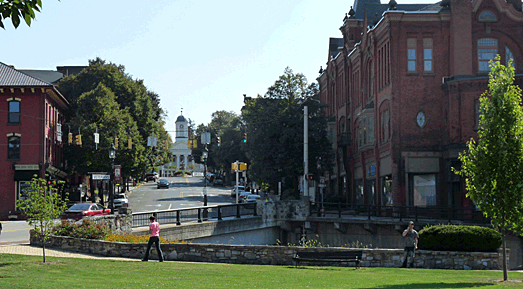
With only about 7,000 residents, it’s the quintessential small
American town of the 1880s, preserved as in aspic for future
generations to enjoy. Visiting it is like taking a trip back to a
more gentile time in American history.
Brief History of Bellefonte
By 1811 Bellefonte had become a dream town in manufacture of iron.
James Dunlop, his son, James, and his son-in-law James Harris had
become successful ironmakers. In 1812, they laid out the town block
by block. As the years went by, Bellefonte boomed and soon became
the most influential town in Pennsylvania between Pittsburgh and
Harrisburg. It also became a frequent stop in the transcontinental
airmail route which ran from New York to San Francisco.
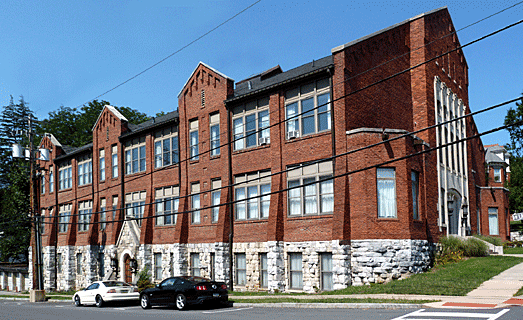
In 1977, the Bellefonte Historic District was added to the National
Register of Historic Places. Other buildings eventually took their
place on the list, including the Bellefonte Armory, Brockerhoff
Hotel, Centre County Courthouse, Gamble Mill, McAllister-Beaver
House, Miles-Humes House, Pennsylvania Match Company, South Ward
School, and the William Thomas House.
While many private homes have been magnificently restored, the town
has had its share of tragic fires which have decimated several grand
public buildings in recent years, including the Bush House Hotel
which burned in 2006, the Cadillac Building which burned in 2009,
and the Garman Opera House and the adjacent Garman House Hotel which
burned in 2012.
Financed by Daniel G. Bush and built in 1868. It was one of the
first hotels in the country to have electric lights. A man would
stand at the train station and call out to the passengers, "Walk ya'
to the Bush House." The Bush House, the Brockerhoff House, the Haag
House, and some other hotels were competitors. Thomas Edison stayed
at the Bush House.
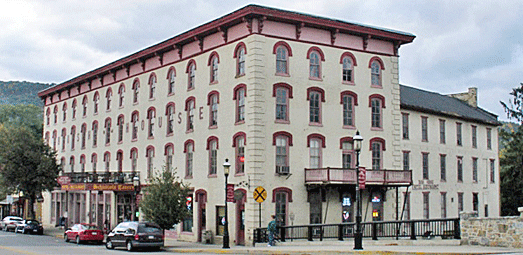
Though heavily damaged by fire, the Cadillac Building, originally
the home of a Cadillac dealership in 1916, has been rebuilt as a
mixed use building.
The Garman Opera House, originally built in 1890, wasn’t so lucky.
Severely damaged by a fire which also destroyed the Garman House
Hotel, it finally had to be razed after preservation groups lost the
battle to save it. The opera house hosted many famous stars of the
day, including George Burns and Gracie Allen, Western performer Tom
Mix, and illusionist/escape artist Harry Houdini. The popular song
"After the Ball" was said to have been first sung in public here. It
was eventually also used as a movie theater, first showing silent
films and then "talkies." It has been replaced by a building housing
21 condominiums.
A Walk Back in Time
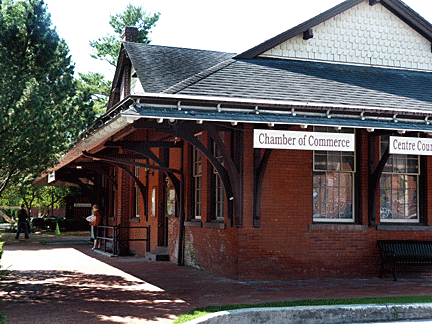 The
best way to enjoy the beauty of Bellefonte’s Victorian architecture
is to walk its quiet streets. The Chamber of Commerce provides a
free map of the Historic District to help first-time visitors see
its beautiful Victorian buildings. Here are some highlights.
The
best way to enjoy the beauty of Bellefonte’s Victorian architecture
is to walk its quiet streets. The Chamber of Commerce provides a
free map of the Historic District to help first-time visitors see
its beautiful Victorian buildings. Here are some highlights.
Beginning at the old railroad station, the tour takes you up High
Street to the Diamond, the town’s center square and the location of
the Court House. On the way, you’ll pass by the Bush Arcade, a row
of storefronts in the simplified Queen Anne style. One block further
stands The Manse, formerly the First National Bank, combines Gothic,
Romanesque, Greek, and Egyptian motifs. Diagonally across from it
stands the Reynold’s House, built by Thomas r. Reynolds in 1880.
Adjacent to it is Petrikin Memorial Hall, designed by Robert Cole
and built between 1901 and 1902 for the Women’s Christian Temperance
Union.
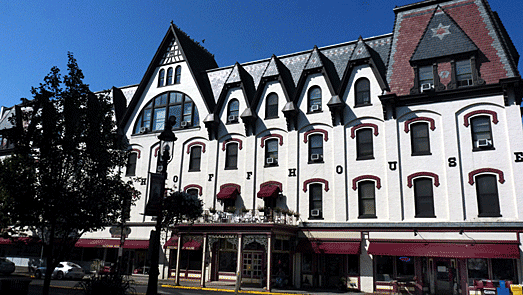
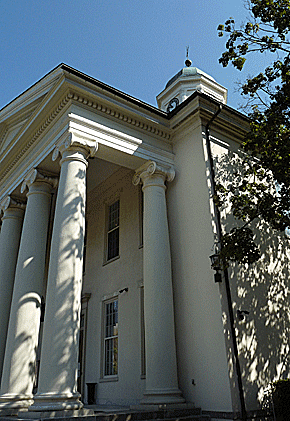 As
you near the Diamond, you’ll be standing beside the Brockerhoff
Hotel, once the site of a log cabin tavern owned by James Benner.
Henry Brockheroff built the Hotel in 1864 and 1865. Robert Cole
redesigned it in the 1890s by adding a fourth floor and modified
mansard roof. It’s a perfect example of Gothic Revival architecture
with Romanesque windows on the front. It has been converted into
apartments.
As
you near the Diamond, you’ll be standing beside the Brockerhoff
Hotel, once the site of a log cabin tavern owned by James Benner.
Henry Brockheroff built the Hotel in 1864 and 1865. Robert Cole
redesigned it in the 1890s by adding a fourth floor and modified
mansard roof. It’s a perfect example of Gothic Revival architecture
with Romanesque windows on the front. It has been converted into
apartments.
Along the eastern side of the Diamond stands the Court House, a
classic example of the Greek Revival style built in 1805 and 1806.
Several wings have been added since. On a side street to the north
of the Court House stands a row of two-story Victorian homes known
as Attorney’s Row, with examples of Italianate, Georgian, and
Pennsylvania farmhouse styles.
The Reynold’s Bank stands on the diagonally opposite corner to the
First National Bank. This bank, along with the Crider Exchange
Building next door burned in 1888 and were rebuilt the following
year. These two buildings are great examples of an eclectic
"anything goes" style.
Along Allegheny Street
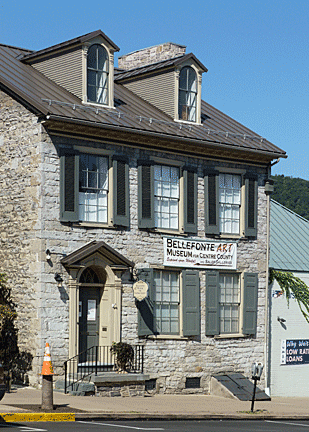 Continuing
north on Allegheny Street, you’ll come to the John Blair Linn House,
originally built in the Georgian style for Judge Jonathan Walker in
1810, now housing the Bellefonte Art Museum. A little further along
is the Potter House, also built in Georgian style in 1815 and now
the public library, Both are on the same side of the street as the
Crider Exchange.
Continuing
north on Allegheny Street, you’ll come to the John Blair Linn House,
originally built in the Georgian style for Judge Jonathan Walker in
1810, now housing the Bellefonte Art Museum. A little further along
is the Potter House, also built in Georgian style in 1815 and now
the public library, Both are on the same side of the street as the
Crider Exchange.
And yet further
along, you’ll come to the Dr. Dartt House, built in 1879, a mixture
of styles, like many in town. The eave brackets along the front and
the tall windows suggest Italianate style, the tall roof and other
features are Gothic Revival, the tall tower Second Empire, and the
wrap-around porch and overall appearance Queen Anne style.
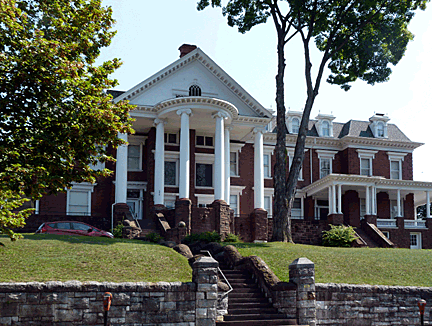 Across
from it stands the Hastings Mansion, once owned by Mrs. John Lane,
then bought and remodeled by Pennsylvania Governor Daniel H.
Hastings. The house is a polyglot of architectural ideas. It could
be called mostly classical with dentiles under eaves, bracketing,
pilasters and pediments on dormers, pillars, leaded windows, large
pane windows, and a mansard style roof. It is said to be haunted.
Across
from it stands the Hastings Mansion, once owned by Mrs. John Lane,
then bought and remodeled by Pennsylvania Governor Daniel H.
Hastings. The house is a polyglot of architectural ideas. It could
be called mostly classical with dentiles under eaves, bracketing,
pilasters and pediments on dormers, pillars, leaded windows, large
pane windows, and a mansard style roof. It is said to be haunted.
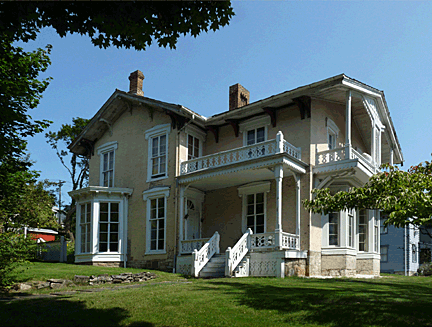 American
Carpenter Gothic style is characterized by steeply-pitched roofs,
steep gables, and pointed-arch windows. Often the construction was
vertical "board and batton" which was considered particularly
fitting for a Gothic cottage because of its upward tendency. When
Gothic came to America and was translated to Carpenter Gothic, the
stone tracery was replaced by wooden gingerbread. Nevertheless,
houses were relatively simple in style.
American
Carpenter Gothic style is characterized by steeply-pitched roofs,
steep gables, and pointed-arch windows. Often the construction was
vertical "board and batton" which was considered particularly
fitting for a Gothic cottage because of its upward tendency. When
Gothic came to America and was translated to Carpenter Gothic, the
stone tracery was replaced by wooden gingerbread. Nevertheless,
houses were relatively simple in style.
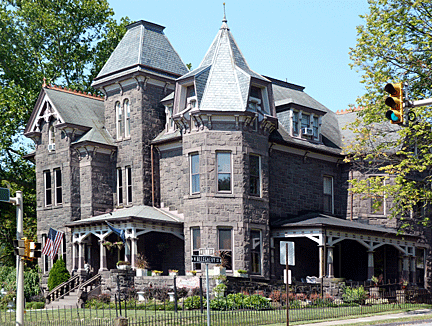 Two
blocks further reveals the Reynolds Mansion on the west and the
Barnard Residence on the east corner of the street. The Reynold’s
Mansion has some Italianate styling, inspired by the country villas
of northern Italy. The body of the house is rectangular. Exterior
wood was scored and painted to resemble stone, which was costly.
Houses were designed with sliding doors that opened into verandas,
where families would gather during the warmth of the summer. An
Italianate house has two or three stories, giving it a “tall”
appearance, flat roof lines, angled bay windows, tall narrow windows
that are L- or U-shaped, and it may have a Corinthian-columned porch
and a cupola.
Two
blocks further reveals the Reynolds Mansion on the west and the
Barnard Residence on the east corner of the street. The Reynold’s
Mansion has some Italianate styling, inspired by the country villas
of northern Italy. The body of the house is rectangular. Exterior
wood was scored and painted to resemble stone, which was costly.
Houses were designed with sliding doors that opened into verandas,
where families would gather during the warmth of the summer. An
Italianate house has two or three stories, giving it a “tall”
appearance, flat roof lines, angled bay windows, tall narrow windows
that are L- or U-shaped, and it may have a Corinthian-columned porch
and a cupola.
Four properties to the east is The Queen, the town’s finest example
of the Queen Anne style.
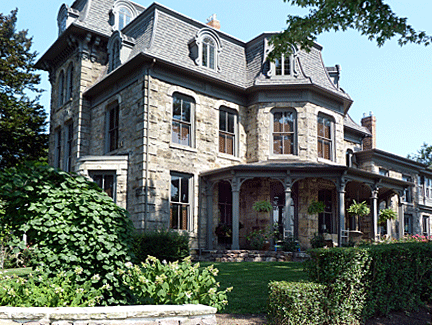 On
the next block, also on the east corner, stands the Ironmaster’s
Mansion, a Second Empire marvel. Paris architecture during the reign
of Napoleon III inspired the Second Empire style, also called
Renaissance Revival. The mansard roof, heavily decorated with dormer
windows, colored tile patterns, and iron cresting, is its primary
feature. Fire extensively damaged the Mansion in 2008 but it has
since been restored.
On
the next block, also on the east corner, stands the Ironmaster’s
Mansion, a Second Empire marvel. Paris architecture during the reign
of Napoleon III inspired the Second Empire style, also called
Renaissance Revival. The mansard roof, heavily decorated with dormer
windows, colored tile patterns, and iron cresting, is its primary
feature. Fire extensively damaged the Mansion in 2008 but it has
since been restored.
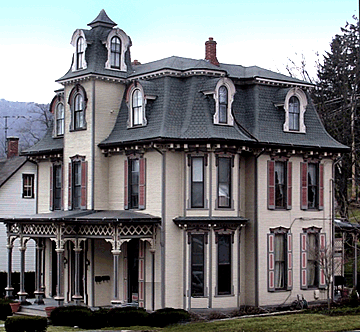 Another
Second Empire example is the Ardell House. John R. Ardell, Jr. Was
an industrialist but is most remembered as the principal lumber
baron of the area. Built in 1883 in Second Empire style, with
mansard roof, eave brackets under all rooflines, and a square tower
in front, it boasts a lavish wooden interior filled with local
hardwoods, including chestnut clapboards, black walnut front door
and banister-railing, poplar pocket doors with hand-stippling, and
red and white oak floors.
Another
Second Empire example is the Ardell House. John R. Ardell, Jr. Was
an industrialist but is most remembered as the principal lumber
baron of the area. Built in 1883 in Second Empire style, with
mansard roof, eave brackets under all rooflines, and a square tower
in front, it boasts a lavish wooden interior filled with local
hardwoods, including chestnut clapboards, black walnut front door
and banister-railing, poplar pocket doors with hand-stippling, and
red and white oak floors.
Architectural historians consider the Stick style to be transitional
between Gothic Revival and Queen Anne. The most distinguishing
characteristic of this style is small vertical, horizontal, or
diagonal planks placed on top of exterior walls, meant to suggest
medieval buildings. The Stick Style also had enormous, overhanging
second story porches, and bayside windows perpendicular to the front
window. Houses built in this style include square bays, flat roof
lines, and free-style decorations. Once Queen Anne houses began to
be built, the Stick style disappeared.
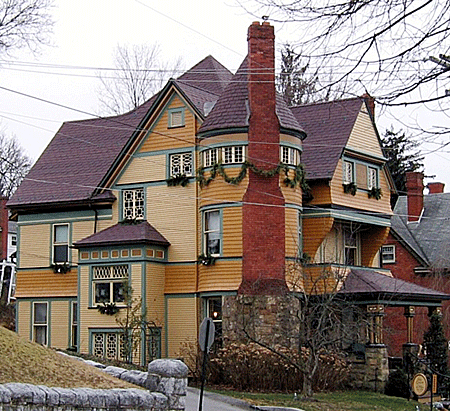 The
most prominent architectural style of the late 19th century was
Queen Anne. Architects designed many Queen Anne houses
asymmetrically. They had varied roof lines, large second story bay
windows, elaborate chimneys, turrets, balconies, dormers, towers,
stained glass decoration, and wrap around porches; elaborate trim
was applied to nearly every surface. This type of ornamental excess
was made possible by power tools and mass-produced trim work. Houses
were painted in a rainbow of dark colors. The Queen is Bellefonte's
best example.
The
most prominent architectural style of the late 19th century was
Queen Anne. Architects designed many Queen Anne houses
asymmetrically. They had varied roof lines, large second story bay
windows, elaborate chimneys, turrets, balconies, dormers, towers,
stained glass decoration, and wrap around porches; elaborate trim
was applied to nearly every surface. This type of ornamental excess
was made possible by power tools and mass-produced trim work. Houses
were painted in a rainbow of dark colors. The Queen is Bellefonte's
best example.
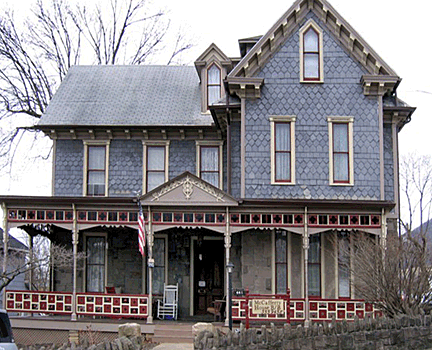 Because
working-class people couldn’t afford fancy Victorian homes, they
preferred what became known as Folk Victorians. After 1870, trains
brought mass-produced architectural trim beyond the cities. A
typical folk Victorian has a square shape, brackets under the eaves,
and porches with spindlework or jig-sawed trim, borrowed from Gothic
Revival style. Many had a low-pitched, pyramidal roof and a front
gable and side wings. Unlike a Queen Anne, a folk Victorian is
symmetrical and lacks towers, bays, and elaborate moldings. The
Charles McCafferty House, the furthest from The Diamond, is an
example of Folk Victorian. McCafferty was Bellefonte's premier
builder during the last half of the 19th century and built many of
the homes on Linn and Curtin streets which are part of Historic
Bellefonte.
Because
working-class people couldn’t afford fancy Victorian homes, they
preferred what became known as Folk Victorians. After 1870, trains
brought mass-produced architectural trim beyond the cities. A
typical folk Victorian has a square shape, brackets under the eaves,
and porches with spindlework or jig-sawed trim, borrowed from Gothic
Revival style. Many had a low-pitched, pyramidal roof and a front
gable and side wings. Unlike a Queen Anne, a folk Victorian is
symmetrical and lacks towers, bays, and elaborate moldings. The
Charles McCafferty House, the furthest from The Diamond, is an
example of Folk Victorian. McCafferty was Bellefonte's premier
builder during the last half of the 19th century and built many of
the homes on Linn and Curtin streets which are part of Historic
Bellefonte.
While there are many other fine Victorian buildings scattered
throughout town, most of the prominent ones are along Allegheny
Street, north of the Diamond.
Take a complete virtual walking tour of Bellefonte's Victorian
buildings.
